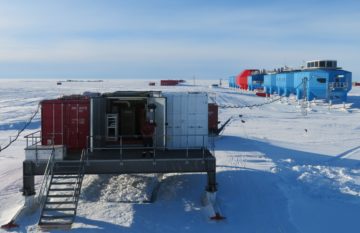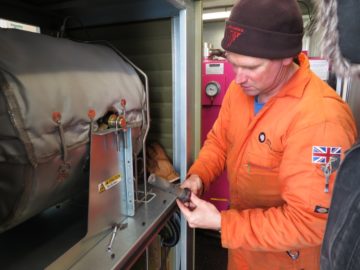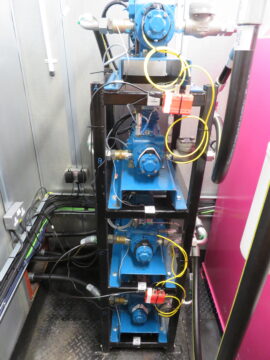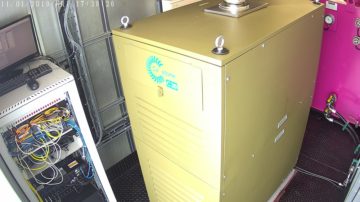Happy at Halley
2 February, 2022 by Emily Neville
Neil Brims is the Electrician at Halley VI Research Station. In our latest blog, find out what life is like at Halley and how it feels to live at the …
Halley Automation
This innovative, multi-year, project aims to provide a micro-turbine power supply and datalink to a suite of autonomous scientific instrumentation around the Halley VI Research Station and on the Brunt Ice Shelf. This system will enable data collection throughout the Antarctic winter when the station may be unoccupied.
This project will preserve core science data streams from Halley:

The Halley Automation Platform, with the Halley modules in the background.
History
Initiated in March 2017, the Halley Automation Project aims to provide a duty and standby micro-turbine power supply and datalink to a suite of autonomous scientific instruments that represent over 90% of the stations Pre-Relocation winter science output.
In 2018-19, the installation and operation of the micro-turbine was successful, as was the set up and installation of almost 80% of the Halley winter science output with the associated real time data link. The micro-turbine and the majority of science experiments ran uninterrupted throughout the nine-month winter period, unmanned, with Halley Station preserving core science data streams such as Meteorology and Ozone Monitoring, Tropospheric Chemistry and Climate, and Space Weather and Upper Atmospheric Observations. The system has run successfully, albeit with a few technical hurdles that have been overcome, up to the present day.

Halley Facilities Engineer, Nicholas Gregory, inspecting one of the microturbine’s igniters.
Innovative Technology
The micro-turbine power generation system (named Capstone C30) was chosen due to its infrequent service schedule (approximately every 8000 hours) allowing the system to run unmanned for the winter period. The system has a bespoke autonomous fuelling system that draws fuel from external tanks into a temperature regulated container hosting the micro-turbine, a suite of internal monitoring systems, as well as control and data acquisition technologies. Fuel transfers from the external tanks into the container are intensively monitored using a range of different devices, from pressure sensors to webcams. This, along with multiple fail safe mechanisms, ensures a safe and environmentally responsible operation. In addition to the automated science experiments, the micro-turbine also powers a real time data link allowing science and system monitoring data to be viewed live from British Antarctic Survey head office in Cambridge, United Kingdom.
The system proved its ability to withstand the Antarctic environment during the 2019 winter; unaffected by ambient temperatures as low as -55˚C and winds gusting up to 70 knots. The system performed approximately 150 autonomous fuelling events throughout the 265-day period and provided an average of 9.5kW of power to the Halley Science network.
The wintering science network consists of several external buildings powered by the micro-turbine. Some buildings are kept warm to protect and maintain the scientific instruments, whilst others are not. Those that are not contain smaller automated experiments contained within self-regulating boxes with smaller heaters, thereby conserving fuel on the micro-turbine where necessary.

The automated fuelling system the feeds the microturbine throughout the winter months.
Net Zero
Automated technologies such as these offer great opportunities to reduce the carbon footprint of research activities in Antarctica. Enabling year-round data collection without the need for human intervention leads to an emission reduction, since the requirement to transport people to difficult-to-reach places and provide a habitable environment for them to live and work in is removed. At Halley, annual fuel consumption has decreased by approximately 75% due to the use of the automated technologies in the winter months. The microturbine system currently burns AVTUR, a fossil fuel, however the system can be adapted to run on synthetic fuels, and this is being pursued in the coming years as we strive towards a net zero research station, alongside more classical renewable technologies, such as solar and wind.

The Capstone C30 microturbine.
Future Plans
The next phase of the project is to increase the resiliency of the electrical network, data capture systems and ensure a duty and standby micro-turbine system to enable full power redundancy. Concurrently, the project will increase the winter science output, primarily focusing on radar instrumentation and optical instruments (Space Weather and Upper Atmospheric Observations) alongside bespoke Greenhouse gas monitoring equipment (Tropospheric Chemistry and Climate).
The C30 micro-turbine is capable of providing up to 30kW of power, and, given the current power consumption of the wintering science network, allows ample room for more experiments. If you are interested in running an experiment at our automated Halley Research facility please get in touch with the Halley Science Coordinator, Thomas Barningham (simbar@bas.ac.uk). During the summer months (November-February) the research station operates at full capacity when scientists utilise the facilities the research platform provides.
Project Manager - Rothera Renewable Energy
AIMP, Meet the Antarctic Infrastructure Modernisation Programme Team
Engineering Advisor
BAS-Arctic Working Group, Antarctic marine engineering team, BAS Management team
Principal Software Engineer
Digital Innovation Team, Artificial Intelligence (AI) Lab, BAS IT team
2 February, 2022 by Emily Neville
Neil Brims is the Electrician at Halley VI Research Station. In our latest blog, find out what life is like at Halley and how it feels to live at the …
13 September, 2023
ANTARCTICA – Following the calving of the A-81 iceberg at the end of January 2023, the Brunt Ice Shelf is moving faster than before. It is currently moving approximately 4 …
23 January, 2023
ANTARCTICA – 23 January 2023. A huge iceberg (1550 km²), almost the size of Greater London, has broken off the 150m thick Brunt Ice Shelf. It calved after cracks that …
26 February, 2021
A huge iceberg (1270 km²) the size of the county of Bedfordshire has broken off the 150-m thick Brunt Ice Shelf, almost a decade after scientists at British Antarctic Survey …
16 September, 2020
This World Ozone Day, British Antarctic Survey (BAS) celebrates new technology which enables continuous monitoring of the ozone hole over Antarctica. Readings from the Dobson Ozone Spectrophotometer at Halley Research …
25 June, 2019
A remote and unoccupied research station in Antarctica has, for the first time, collected important scientific measurements of climate, ozone and space weather thanks to ground-breaking technology developed by British …
27 February, 2019
British Antarctic Survey (BAS) Halley VI Research Station has closed for the 2019 Antarctic winter after a successful summer field season. It will re-open again in November this year. The …
31 October, 2017
British Antarctic Survey (BAS) has decided, for safety reasons, that it will close its Halley VI Research Station during the 2018 Antarctic winter. This will be the second time that …
16 January, 2017
British Antarctic Survey (BAS) has decided not to winter at Halley VI Research Station for safety reasons. The station, which is located on the floating Brunt Ice Shelf in Antarctica, …